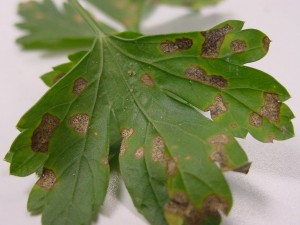Septoria leaf spot (SLS) in Parsley can cause significant losses in fields where it has become established. Like other Septoria’s, the leaf spots produced on parsley look much like the leaf spots produced on tomatoes and other crops. Septoria leaf spot overwinters from year to year on infected debris so long crop rotations of 2 or more years are important to help reduce disease pressure. During the season, SLS will spread rapidly with each subsequent rainfall and/or overhead irrigation event. Therefore, early detection and preventative fungicide applications are key to successfully controlling SLS. There have been a few new fungicides labeled for SLS control in the past few years.

Septoria leaf spot of Parsley
To help reduce disease pressure from bacterial and fungal diseases, rotate with non-related crops for at least 2 years. Space successive plantings in the same year as far apart as possible. Heavy winds and rain may damage leaves and predispose leaves to bacterial infections.
Bacterial leaf blight: Prevention is key. Avoid working in the fields while the foliage is wet to help reduce spread. Scout fields on a regular basis for early symptoms, apply fixed copper at labeled rates with regular maintenance applications for leaf spot diseases and repeat every 7 days. Some copper-based products are OMRI-approved and can be used in organic production systems for the suppression of bacterial and some fungal diseases.
Septoria leaf spot: Early detection and prevention are key. Scout daily, and apply fungicides preventatively before first leaf spots appear. Early season infections (i.e., prior to first cutting) will severely reduce subsequent harvests.
For more information on controlling these diseases, please see the parsley section in the 2024/2025 Mid-Atlantic Commercial Vegetable Production Recommendations Guide.

